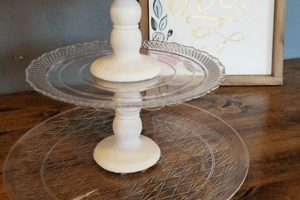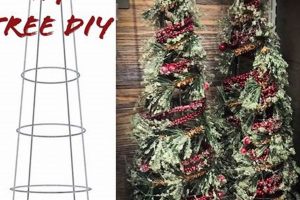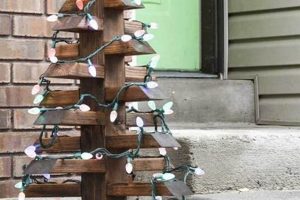The crafting of miniature, self-assembled holiday centerpieces from cellulose-based material constitutes a popular seasonal activity. These constructions, often employing techniques such as folding, cutting, and gluing, provide a tangible representation of festive spirit. A common example involves meticulously folding sheets of green paper into cones and layering them to mimic the appearance of a traditional evergreen.
The appeal of such projects lies in their accessibility, affordability, and potential for personalization. They present an economical alternative to purchasing commercially produced decorations and foster creativity through customization of size, color, and embellishments. Historically, handcrafted ornaments have offered a means of celebrating traditions within budgetary constraints and emphasizing individual artistic expression.
This exploration will delve into various methods for creating these festive decorations, outlining essential materials, step-by-step construction guides, and diverse design inspirations to elevate holiday ornamentation.
Tips for Constructing a Successful Paper Holiday Tree
The creation of a visually appealing and structurally sound paper holiday tree requires careful planning and execution. Adherence to specific guidelines can significantly enhance the final product.
Tip 1: Material Selection is Critical: Opt for paper stock with sufficient weight to maintain structural integrity. Cardstock or heavier construction paper is preferable to standard printer paper, preventing drooping and collapse.
Tip 2: Precision in Cutting and Folding: Accuracy in measurements and execution of folds directly impacts the symmetry and overall appearance of the tree. Utilize templates and rulers to ensure uniformity.
Tip 3: Secure Adhesion is Essential: Employ a high-quality adhesive, such as craft glue or a glue stick, to firmly secure layers and components. Allow adequate drying time to prevent separation.
Tip 4: Graduated Layering Enhances Realism: Vary the size of each layer to create a tapered effect, mimicking the natural form of a coniferous tree. Incremental reductions in diameter yield a more realistic silhouette.
Tip 5: Structural Support Considerations: For larger trees, incorporating an internal support structure, such as a cardboard cone or wooden dowel, provides stability and prevents distortion.
Tip 6: Embellishment Strategy: Plan embellishments in advance to ensure cohesive design. Consider using lightweight materials to avoid overburdening the paper structure. Glitter, beads, and miniature ornaments can add visual interest.
Tip 7: Base Stability: Design a stable base to prevent the tree from toppling. A wider base provides a lower center of gravity, enhancing overall stability.
By implementing these suggestions, individuals can increase the likelihood of crafting a durable and aesthetically pleasing paper holiday tree, suitable for display and seasonal enjoyment.
The following section will address advanced techniques and artistic variations for more elaborate projects.
1. Paper Selection
The choice of paper is paramount in the successful creation of miniature holiday trees using paper-based materials. It fundamentally influences both the structural stability and the visual aesthetic of the finished piece, impacting its longevity and perceived quality. Therefore, a careful assessment of various paper characteristics is essential.
- Weight and Thickness
Paper weight, measured in grams per square meter (gsm) or pounds (lb), dictates the paper’s rigidity. A heavier paper, such as cardstock (above 200 gsm), provides increased structural support, preventing the tree from collapsing under its own weight, particularly in larger designs. Conversely, lighter papers, while easier to fold, are prone to bending and deformation. For example, using printer paper (around 80 gsm) for a large paper tree would likely result in a flimsy and unstable structure.
- Color and Texture
Color and texture significantly impact the visual appeal. Green is a common choice to mimic a traditional evergreen, but varied shades and textures can add depth and realism. Textured papers, such as those with a linen or hammered finish, introduce tactile interest. The color fastness of the paper is also crucial; low-quality colored paper may fade over time when exposed to light. The selection of color should consider the desired aesthetic, from realistic to whimsical.
- Foldability and Crease Retention
The paper’s ability to fold cleanly and retain a crease is crucial for designs that require intricate folds. Paper with a high fiber content often folds sharply without tearing or cracking. Papers treated for origami, for example, are specifically designed for excellent crease retention. A paper that springs back after being folded will make it difficult to create well-defined shapes, undermining the structure of the project.
- Recycled Content and Sustainability
In an era of heightened environmental awareness, the inclusion of recycled content in paper selection is a relevant consideration. Choosing recycled paper aligns with sustainable practices. However, it’s important to note that the recycled content can sometimes impact the paper’s strength or color consistency. Therefore, careful evaluation of the recycled paper’s properties is still necessary to ensure it meets the project’s requirements. For instance, 100% post-consumer recycled paper may have a slightly different texture or color than virgin paper.
In conclusion, the strategic paper selection is vital. Choosing paper with appropriate weight, color, folding capability, and sustainable attributes contributes significantly to the success and longevity of paper holiday tree projects. Neglecting these attributes can result in unstable, visually unappealing, or environmentally unsound outcomes.
2. Folding Technique
The method of folding significantly dictates the final form and structural integrity of a paper-based holiday tree. Precise and consistent folding is paramount for achieving the desired aesthetic and stability.
- Modular Origami Assembly
This technique involves creating numerous identical folded paper units (modules) which are then interlocked to form a larger structure. For a paper holiday tree, individual modules might be folded into triangular or conical shapes. The complexity and number of modules directly influence the tree’s size and intricacy. This method allows for intricate designs and a high degree of customization. An example is Sonobe units joined to create a geometric tree structure, emphasizing mathematical precision in design.
- Spiral Cone Construction
Spiral cone construction relies on cutting and folding paper into progressively smaller cones that are stacked upon one another to simulate the tiered structure of a fir tree. The accuracy of the cone dimensions and the tightness of the spiral significantly affect the overall appearance. This is a simpler approach compared to modular origami, making it suitable for beginner crafters. An example is using circular paper cutouts with a section removed to form cones, layered with decreasing diameters to create the tree’s shape.
- Kirigami-Inspired Techniques
Kirigami, a variation of origami that involves cutting paper, can be incorporated to add detail and complexity. Intricate patterns can be cut into the paper before or after folding to create textured surfaces or represent branches and foliage. This technique requires sharp tools and careful execution to avoid tearing the paper. An example includes making precise cuts into folded paper to create a three-dimensional “pop-up” tree effect when the paper is unfolded.
- Pleating and Accordion Folding
Pleating and accordion folding create a repetitive, rhythmic texture. These techniques can be used to create individual branches or layers of the tree. The width and spacing of the pleats affect the density and appearance of the foliage. Consistent pleating is essential for a uniform and visually appealing result. An example is accordion-folding green paper and then attaching it to a central cone to create a dense, bushy effect.
Each folding technique offers distinct advantages and limitations for paper tree construction. The selection depends on the desired aesthetic, complexity, and the crafter’s skill level. Combining multiple techniques can yield unique and visually arresting designs. Regardless of the chosen method, precision and patience are critical for a successful outcome.
3. Adhesive Application
Adhesive application constitutes a critical phase in the creation of paper-based holiday trees. The success of the entire project is directly contingent upon the correct selection and implementation of an appropriate adhesive. Insufficient or improperly applied adhesive leads to structural failure, compromising the visual appeal and longevity of the tree. Conversely, skillful application ensures the secure bonding of components, resulting in a durable and aesthetically pleasing final product. For example, using a weak glue stick on a multi-layered tree assembled via modular origami results in the modules separating over time, detracting from the piece’s intended form.
Practical significance extends beyond mere assembly. The type of adhesive impacts the visual quality. Excessive application of wet glue can warp delicate paper, creating unsightly distortions. Conversely, insufficient adhesive results in poorly bonded seams, creating visual gaps and structural weaknesses. Therefore, strategic adhesive application constitutes an art in itself. Consider the application of archival-quality PVA glue to acid-free paper components. This ensures that the holiday decoration not only maintains its structural integrity but also resists yellowing and degradation over time, extending its usability for years. Furthermore, the correct adhesive enables the addition of embellishments such as glitter, beads, and small ornaments without causing detachment, improving the design and the holiday decoration.
In summary, adhesive application is not a trivial step but a fundamental component in paper-based holiday tree construction. Selection of a suitable adhesive, coupled with precise and controlled application, directly determines the structural integrity, visual appeal, and long-term durability of the creation. Challenges related to paper warping, insufficient bonding, and detachment of embellishments can be avoided through informed adhesive selection and meticulous application techniques, ultimately contributing to a successful outcome.
4. Structural Integrity
The capacity of a self-assembled paper holiday tree to withstand external forces and maintain its intended shape defines its structural integrity. In the context of constructing these decorative objects, several factors influence this characteristic. The primary material, paper, inherently possesses limited strength. Therefore, design and assembly techniques must compensate to achieve acceptable stability. Insufficient structural integrity results in collapse, deformation, or limited display lifespan. A paper tree constructed solely from thin printer paper, without internal support or reinforcement, serves as an example of inherent instability. Conversely, a tree employing thicker cardstock, strategically layered or folded for increased rigidity, demonstrates enhanced structural resilience. The method of joining components, whether through adhesive bonding or interlocking folds, significantly affects the load-bearing capacity and overall durability. Poorly executed adhesive joints or weakly interlocked folds compromise the structure, leading to premature failure.
Practical implications of understanding structural integrity extend beyond mere aesthetic considerations. A structurally sound paper tree is less susceptible to damage from handling, environmental factors such as humidity, or accidental impacts. This reduces the need for frequent repairs or replacements, increasing the overall value and sustainability of the decorative item. Furthermore, comprehending the principles of structural integrity facilitates the creation of larger, more complex paper tree designs. Employing techniques such as internal supports made from cardboard or wooden dowels can significantly increase the load-bearing capacity of the structure, enabling the creation of impressive displays that would otherwise be impossible. Consider, for example, a large paper tree intended as a centerpiece for a holiday gathering. If properly engineered with attention to structural integrity, it can serve as a visually striking and durable focal point throughout the festive season.
In summary, structural integrity is a critical element in the design and construction of paper holiday trees. Material selection, assembly techniques, and the incorporation of reinforcing elements directly impact the object’s stability and longevity. By prioritizing structural considerations, creators can produce durable, visually appealing decorations that withstand the rigors of display and handling, contributing to a more sustainable and aesthetically satisfying holiday experience. Addressing the inherent limitations of paper through informed design choices is essential for realizing the full potential of these handcrafted decorations.
5. Decorative Embellishments
The aesthetic appeal of a self-constructed paper Christmas tree is significantly enhanced through the application of carefully selected decorative embellishments. These adornments serve as the finishing touches, transforming a basic paper structure into a visually compelling representation of the holiday spirit. The cause-and-effect relationship is direct: the addition of embellishments elevates the tree from a simple craft project to a personalized festive ornament. These additions are not merely superficial; they are integral components, determining the overall character and reflecting the creator’s individual style. Real-life examples include the application of glitter to simulate snow, the addition of miniature ornaments to mimic a traditional tree, or the use of paint to create unique patterns and textures. The practical significance of understanding this lies in maximizing the visual impact of the finished product, increasing its perceived value and sentimental worth.
Further analysis reveals that the choice and application of embellishments require careful consideration. Overly elaborate or poorly executed embellishments can detract from the overall aesthetic, creating a cluttered or unbalanced appearance. Conversely, a minimalist approach, employing only a few well-chosen elements, can achieve a sophisticated and elegant result. Practical applications include experimenting with different materials, such as beads, sequins, ribbons, or even repurposed items, to discover unique and personalized effects. The use of hot glue, for example, allows for the secure attachment of heavier or three-dimensional embellishments, while the application of spray adhesive facilitates the even distribution of glitter. Exploring various techniques allows artisans to achieve desired aesthetics, contributing to the visual integrity and holiday thematic representation.
In conclusion, decorative embellishments are intrinsically linked to the success of a paper Christmas tree project. They function as a critical layer of aesthetic enhancement, directly influencing the final appearance and reflecting individual creativity. Challenges lie in achieving a balanced and harmonious composition, requiring thoughtful selection and skillful application of adornments. Mastering this aspect elevates the craft from a simple activity to a refined art form, aligning with the broader theme of creating meaningful and personalized holiday decorations. Understanding the critical role and various techniques enables successful decoration, culminating in a tangible representation of the christmas aesthetic.
Frequently Asked Questions
This section addresses common inquiries regarding the construction, materials, and techniques involved in creating miniature holiday trees from paper. The answers provided aim to offer clarity and guidance for achieving successful project outcomes.
Question 1: What type of paper is most suitable for crafting durable paper holiday trees?
Cardstock, with a weight of 200 gsm or higher, is generally recommended for its superior rigidity and structural support. Thinner papers, such as standard printer paper, are prone to bending and collapse.
Question 2: How can intricate designs be achieved without tearing the paper during folding?
Employ techniques such as scoring the paper along fold lines prior to folding. This creates a weakened area that facilitates clean, sharp creases and reduces the risk of tearing, especially when working with thicker paper stocks.
Question 3: What adhesive type provides the strongest and most reliable bond for paper components?
PVA-based adhesives, such as craft glue, are generally preferred for their strong bonding capabilities and minimal warping effect on paper. Hot glue can also be used but requires careful application to prevent burning the paper.
Question 4: How can stability be ensured for larger paper holiday tree constructions?
Incorporate an internal support structure, such as a cardboard cone or wooden dowel, to provide additional stability. The support structure should be securely anchored to the base of the tree.
Question 5: What methods are most effective for preventing glitter from shedding excessively from embellished paper trees?
Employ a sealant, such as a clear acrylic spray, to encase the glitter particles and prevent them from detaching. Apply the sealant in thin, even coats to avoid dissolving the glitter or distorting the paper.
Question 6: How can moisture damage to paper holiday trees be mitigated, particularly in humid environments?
Apply a moisture-resistant coating, such as varnish or lacquer, to protect the paper from absorbing atmospheric moisture. This is especially important for trees intended for display in areas with high humidity levels.
The successful construction of durable and visually appealing paper holiday trees relies on informed material selection, precise execution of techniques, and strategic application of protective measures. Adherence to these guidelines can significantly enhance the quality and longevity of these handcrafted decorations.
The following section will delve into advanced design considerations and artistic inspirations for paper holiday tree projects.
DIY Paper Xmas Tree
This exploration has underscored the multifaceted nature of the DIY paper xmas tree. Key points encompass material selection’s influence on structural integrity, the crucial role of precise folding techniques in achieving desired aesthetics, the strategic application of adhesives for durable assembly, and the impact of embellishments on the final visual presentation. Understanding these elements is critical for constructing aesthetically pleasing and structurally sound holiday decorations.
The construction of a DIY paper xmas tree transcends mere crafting; it represents a synthesis of artistic expression, technical skill, and festive spirit. By applying the principles outlined, individuals can elevate their seasonal decor and contribute to a tradition of personalized craftsmanship. Continued refinement of these techniques will undoubtedly yield even more innovative and captivating paper holiday creations in the future.







